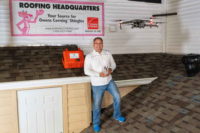Severe weather events can put the entireroofing industry to the test. Manufacturers, distributors and contractors all have to mobilize quickly to help people in the affected area rebuild. Storms can put a strain on all members of the supply chain at a difficult time — and the strain is exponentially increased when the disaster also affects a key manufacturing site.
That was the case in Kearny, N.J., on Oct. 29, 2012, when Superstorm Sandy inundated the East Coast and devastated the Owens Corning Roofing and Asphalt plant. The company’s struggle to rebuild the facility while continuing to service its customers and help the area rebuild is a success story that is a credit to the company and the industry it serves.
During a recent visit to the reconstructed state-of-the art facility, Roofing Contractor spoke about the storm and its aftermath with members of the Owens Corning team including David Kenna, Kearny site leader; Guy Baker Jr., area sales manager; Andy Bohman, operations leader; Paul Pohlid, maintenance leader; Nicholas Jayme, electrician and steward for Teamsters Local 560; Sue Burkett, marketing leader; and DeAnna Starn, PR/social leader.
Sitting at the confluence of the Hackensack and Passaic Rivers with access to Newark Bay, the Kearny site serves the entire Northeast region. It manufactures shingles and incorporates more than 60 different SKUs, including the TruDefinition® Duration® shingles featuring SureNail® Technology. The union-affiliated plant is the workplace for 100 employees. It’s also a central distribution site for other products and accessories.
According to Kenna, the company evacuated the plant and took precautions in advance of the storm, but the storm surge overwhelmed the pumping system and the backup generators. “If you were in the wrong place you were in the wrong place when Sandy hit,” he said. “I guess it was the perfect storm. It hit at the highest tide possible on that particular day.”
The storm surge was estimated between 12 and 14 feet, and immediately after the storm ended it was impossible to determine just what type of damage had been done. The New Jersey Turnpike was closed, and the state police wouldn’t allow Owens Corning employees to access the plant for two days. When they were able to visit the plant, they had to do it in waders. The site was still under 4 or 5 feet of standing water, which reached the level of the loading dock. “Unfortunately when we got into the site, it was pretty obvious that not only did we have 4 feet of water outside, but we had probably gotten another 5 feet of water inside the building at one stage,” said Kenna.
Assessing the Damage
The first priority was to conduct a damage assessment. The task was daunting. There was no power at the site. Oil drums, 100-pound gas containers and kegs of asphalt had been thrown around like toys. The electrical systems had all been submerged in saltwater and would have to be replaced. The offices, furniture and supplies were ruined. All of the raw materials on the site had been damaged, as well as any finished product, including pallets of shingles. All motorized tools, equipment and vehicles, including 14 fork lifts, had to be scrapped. On the asphalt side of the plant, the shipping trailer had been overturned, and an empty 50,000-barrel storage tank had been moved off of its foundation.
“Our first order of business was just to pump the site dry,” Kenna said. There was no power, so they had to rent generators and pumps, which were tough to locate. “Everyone was looking for generators. Everyone was looking for pumps,” Kenna said. “It wasn’t like you could easily put your hands on these things.”
They leaned on Owens Corning’s Central Support Groups for assistance. “We needed help from Toledo from our sourcing group to get a lot of things in here, and then of course they ran on diesel, and it was almost impossible to get gas,” Kenna said. “At the end of the day, we did manage to get all of the water off the site.”
Taking Care of Employees and Customers
As the Kearny team stabilized the site, the company mobilized to help its employees and reassure customers. “The crisis management piece has to click in,” Kenna said. “There are a number of elements you have to think about at that stage. First of all you have the employees. We had been flooded out, but some of the employees had also been affected. If we could, we helped them out with generators or whatever they needed. We also had to let the folks know that we weren’t going to be starting up the following Monday.”
The company had to let the operations employees know that they would be furloughed for an indefinite period of time. “We had to help workers sign up for unemployment, and that’s hard to do when you don’t have a phone system and you don’t have any infrastructure, so again that was done remotely by our HR team in Maine and Ohio,” Kenna said.
At the same time, the customer service team had to swing into action to reassure contractors and distributors it could meet their needs even though so much product had been destroyed. “This was a busy time after the storm,” Baker said. “People needed a lot of roofing. We had to assure the distributors and contractors and homeowners that there wouldn’t be a delay in getting them product.”
Owens Corning’s other plants were ready to help out. “We have our Regional Shingle Program, and other plants chipped in to help, including Savannah and Atlanta,” said Kenna. “People in the Northeast didn’t see any interruption in their business.”
According to Sue Burkett, the Regional Shingle Program focuses on shingles from different plants in the same region having the exact same make-up and color. The goal is to avoid color variations that would have to be marked “do not mix,” which can be an inconvenience for contractors and distributors. “So for a number of years we’d been developing this regional shingle program, which is really focused on shingles looking exactly the same from any of those plants, so it truly is transparent,” Burkett said. She noted that the plan was already in place with most of the company’s shingle colors, and within two or three weeks of the storm, all of the remaining colors were certified under the program.
Kenna praised the teams at the other plants for their efforts. “A lot of work was done at the other sites to back us up,” he said. “It was truly a team effort. We were in the thick of it just from the rebuild, but the other sites took up the slack to make sure our customers were taken care of.”
The Cleanup
With the employees and customers taken care of, the next step was to clean up the site and determine if the plant could be rebuilt. There were important safety considerations, including mold and possible contaminants in the flood water. The company had to locate protective equipment and make sure everyone had a tetanus shot. “We had to put some infrastructure in place,” Kenna said. “We had more trailers than you could shake a stick at — and getting trailers wasn’t easy, either. Getting those in here and getting power to them was no mean feat, and most of that work was done by our crew here.”
A professional flood mitigation company was called in, and by mid-November the entire place was ripped out to the studs. “The place was just gutted,” Kenna said. “Everything went.”
Walls had to be steam cleaned as high as 10 feet. The lines and plant equipment that they could keep had been exposed to saltwater, so everything had to be cleaned and treated. “You have to stop the corrosion, so everything in the plant had to be steam cleaned and sprayed with WD-40 or something similar,” Kenna said.
Travel was difficult, and hotel rooms and rental cars were hard to find. There was no Internet access, so air cards had to be purchased to get employees online. Workers took turns lining up to get gas to keep the generators going.
“You’re purchasing everything — even paper clips,” Kenna said. “One thing I was really impressed with was the crisis management of Owens Corning, because purchasing had to be involved, HR — every element gets involved. We wouldn’t have been able to lay our hands on any of this without their help.”
Rebuilding the Plant
All in all, the cleanup took about three months. By the time it was completed in January of 2013, the decision had been made to rebuild. Since so much equipment had to be replaced, the company seized the chance to upgrade the plant with state-of-the-art equipment. New technology was implemented in the control platform, line drives and tension control system. An automated granule system and new packaging system were added. The company also committed to launching the new Devonshire shingle line at the plant. “Owens Corning has a very good planning process, so a lot of the work was already in place as far as the advancements in technology that were going to take place in the future,” Kenna said. “This turned out to be the largest investment OC has ever made in a roofing plant.”
The planning was managed internally by Owens Corning. An outside engineering firm was brought in to handle construction, using local labor from New Jersey and New York-based companies. “We have go-to partners who can come in and hit the ground running who have familiarity with the facility,” said Kenna. “We mobilized and had contractors on the site in February.”
Between February and July, construction continued with three shifts working around the clock. One of the greatest challenges was that all of the wiring had to be replaced. Kenna estimates that more than 1 million electrical connections were made and tested. “When you think about one million connections — and I’m probably being conservative in that number — the fact we came up so quickly is amazing to me,” he said.
Getting Employees Back Up to Speed
In June, the employees were brought in for classroom training to educate them on the new technology. “We have an engaged, knowledgeable workforce here, but they had been out of work for seven or eight months, and they needed to be trained on the new equipment,” Kenna said. “We wanted those people in to run our facility once it was up and running. At the end of the day, 95 percent of our workforce came back in.”
Employees had to familiarize themselves with the new equipment and the new plant layout. All of the procedure manuals and job hazard analyses had to be rewritten. “There were a lot of different nuances people had to become familiar with,” Kenna said. “This was a massive project. In terms of Owens Corning Roofing, nothing like this had ever been done before.”
The plant came online in late June, and it was fully operational and began shipping product in July. The ability to draw on the expertise of the teams at the company’s other plants was crucial, noted Kenna. “When we started up our plant, we were able to get knowledgeable people from all of those plants to come in and help us from a commissioning standpoint,” he said. “You can draw on a pretty good knowledge base from those 14 sites, and that was another reason we were able to get the plant up and running so quickly.”
The project won the Board of Directors’ Cup, the highest award given at Owens Corning. It is presented to the team that best uses the company’s resources to deliver extraordinary results for its customers, employees and shareholders.
The Owens Corning team believes the company’s performance in the crisis brought all of the company’s stakeholders closer together. “Our core operations guys lived in hotels eight or nine months and worked around the clock,” Bohman said. “We really appreciate them putting in those tough hours and spending that time away from their families.”
Jayme noted that workers were excited to return to work when several other facilities in the area had been abandoned. “It was a blessing that the company decided to rebuild the plant,” he said. “It was a relief to know we were coming back to a job.”
“The measure of true character is how it works during the bad times,” said Burkett. “I’d say our relationships have been further cemented because it doesn’t get much worse than this. It really does speak to who Owens Corning is. While this particular event was unique, this is what we do. After a hurricane, a plant might not go down like this one did, but you still have pressure on your product, and other plants have to kick in. We have proven to our customers that when times are tough, this is who Owens Corning is.”









